We’ve been a part of peer-to-peer marketplace development for a while, and it’s been full of exciting development. The industry is at a high pace: up to 2025, the value is predicted to reach 335 billion dollars.
As an online marketplace development team, we’ve been building peer-to-peer platforms for many years, and we’ve been expecting the rise of peer-to-peer marketplaces. So far, a lot of niches are still free of significant competition – another reason to consider this marketplace business model.
Classical industries already emerged of the market: people paying others to perform housework, provide business support, or educational services. So, our team of marketplace developers prepared a guide to peer-to-peer online marketplace development – since it’s one of the major e-commerce trends of 2021. You can also read how to build an online marketplace in another our post.
Use cases for a p2p marketplace
Peer to peer marketplace definition is an online platform where users exchange goods and services, creating a user-driven market. There’s no centralized seller or an official authority – visitors are the ones to drive purchases. Online ecommerce marketplace development relies on communities and versatile user functions – this is the core of the business model.
There are many industries where peer to peer marketplace platforms are likely to be an efficient business model. Here are just a few examples to illustrate the main possibilities of online ecommerce marketplace development.
- Consulting: users look for experts in various fields and reserve a conversation/consults;
- Renting: users rent goods, services;
- Shared economy: instead of buying a product, users can share it with others, saving money and preventing over-consumption;
- Counseling: users who struggle with mental diseases can connect with therapists and psychologists to get professional assistance;
- Communication: users find interesting conversation partners, incentifying them with a monetary bonus
- Education: users learn languages by paying teachers or native speakers to talk to them.
The point is, the applications of peer-to-peer chat marketplaces are almost limitless. Especially now, when we are facing the aftermath of the COVID pandemic – it’s obvious that online communication will prevail for long.
In the US, more than 79% of Americans switched to digital communication during the pandemic. By hiring a reliable marketplace development company, you can leverage on this spike of interest in peer-to-peer development, and the trend will likely continue.
How to start developing a peer to peer marketplaces?
Building a peer marketplace requires a specific approach. The functionality should be secure, ethical, easy-to-manage, and transparent.
Determining functionality of peer-to-peer marketplace: examples
Here’s an excerpt from the list of questions that we ask our clients/partners who are interested in the ecommerce marketplace development.
What’s the type of the project?
- Peer-to-peer: the stream of revenue flows from user to another, no centralized provider;
- Centralized: there is one or several providers, favored by the system. These can be expert vendors, hired by the official team, distributors, confirmed partners, etc.
- E-commerce: the chat services are presented with the same algorithms as products in e-commerce, from functionality to revenue.
At this stage, marketplace developers determine if the business model is really suited for a peer-to-peer business model, or centralized/e-commerce models will deliver better results. Misunderstanding user roles is one of the main online marketplace development pitfalls in peer-to-peer projects. If the team doesn’t understand interactions between community members, they can’t manage it effectively. So, defining a type of peer-to-peer project is the first step.
This is HLPRS, a P2P service marketplace website built by a Syndicode. Together with a product owner, we chose a P2P service-oriented business model.
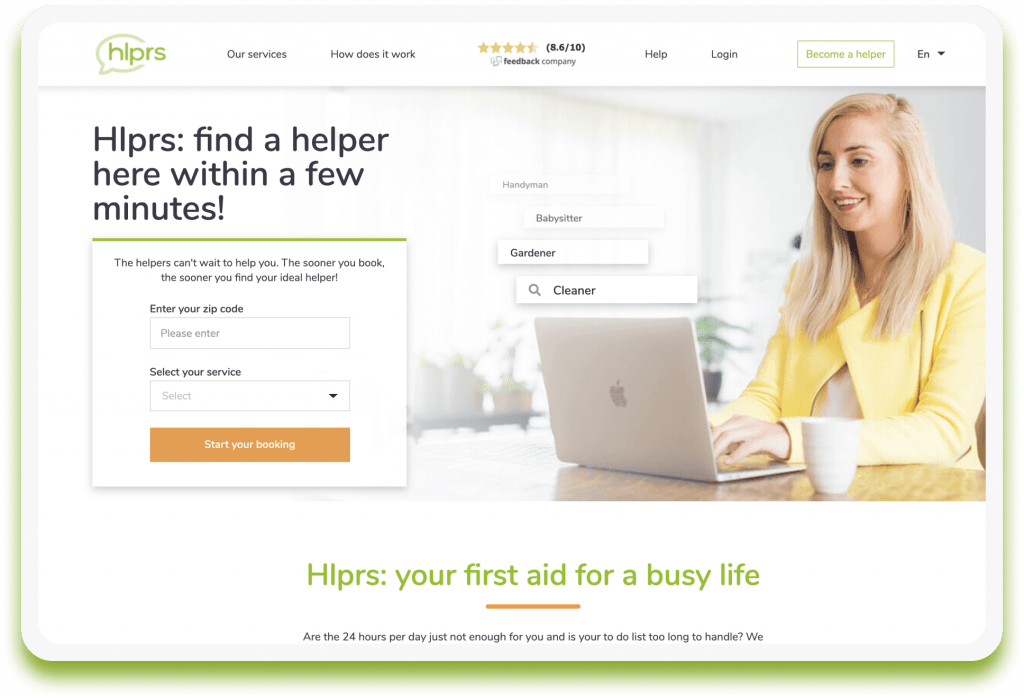
- Each user can sell their time on the platform, there’s no fixed status (an open peer-to-peer marketplace website)
- Every user has a status – it implies the division between speaker-listener, student-teacher, expert-learner (role-based custom marketplace).
Understanding of user roles helps the development team to develop a unique registration system. Marketplace developers decide how many types of profiles are necessary and what are the interactions between multiple roles. Here’s how to start defining user roles in any peer-to-peer e-commerce marketplace development project.
Roles and access
- What are the roles in the peer-to-peer custom marketplace? For a chat platform, these roles are typically 1) the initiator of the conversation 2) the provider of the service. iTalki is an example of such a division: there’s a student who wants to learn a language, and a teacher, willing to dedicate time and receive compensation.
- What features are essential for each role? In our HLPRs multi-vendor marketplace platform, we divided users by household owners and helpers. Owners had a profile where they could manage their helpers, leave reviews, plan activities. Helpers managed their schedules, fees, lists of services, hourly rates, etc.
- Which role is a higher priority on the platform? Not all peer-to-peer custom marketplaces are fully balanced. If the demand for a service is high, the provider will have an upper-hand. On most multi-vendor marketplaces, though, users who order services typically have more influence over rating, reviews, cancellations, etc.
- Who has most permissions: peer-to-peer and centralized marketplaces give higher priority to dealers (Dealer Status), partners (Partner Status), moderation, and an official marketplace website team.
Here’s how our marketplace developers did it in HLPRS:
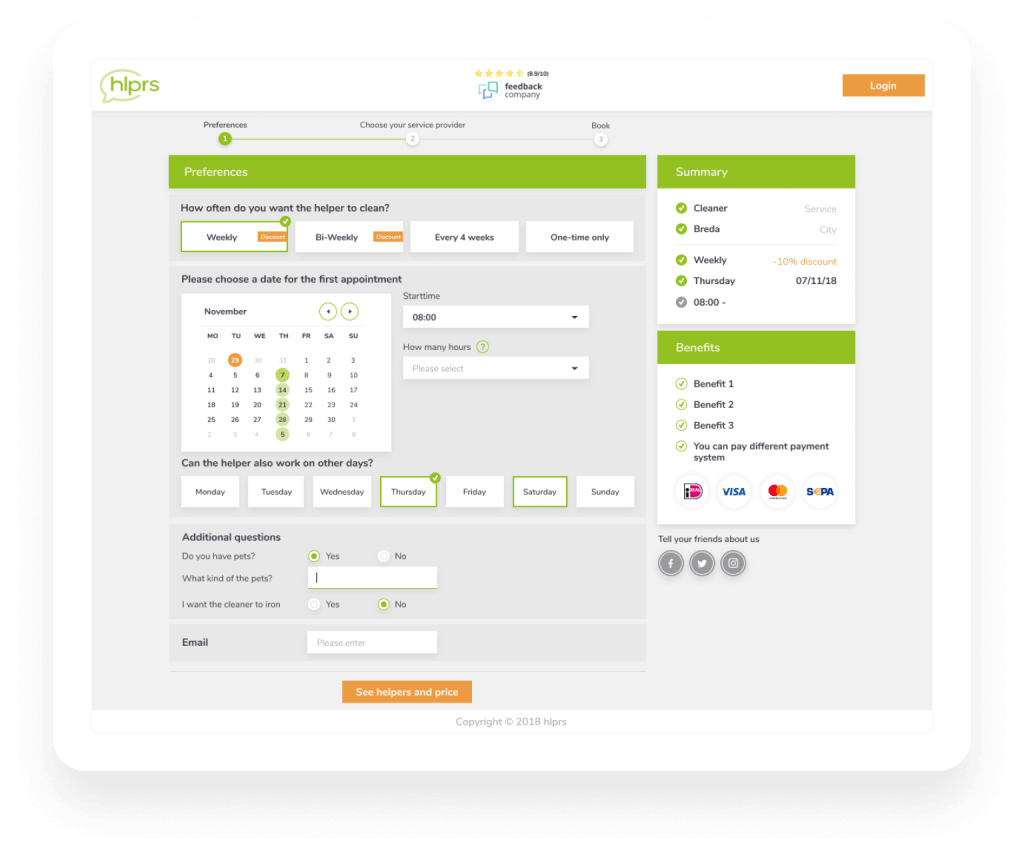
At this stage, we determine which users have more rights on the platform and who will be the main target audience of the online ecommerce market. Marketplace developers also determine highly specific interests for each target group and develop compensatory mechanisms – ways to help all users, even lower-priority ones, feel comfortable and safe.
Monetization
- Free trial: does a p2p lending marketplace have a free trial? If so, who is granted privileges? We call it demo-functionality: it has to be a trimmed version of all the features and interface.
- Paid trial: eventually, multi-vendor marketplaces can switch to paid trial versions – users need to make a purchase but it costs less than normal plans.
- Flat fee or pay-per-use: a custom marketplace website can charge on a monthly or yearly basis regardless of users’ activity (a flat fee).
- Advertising: service providers can pay the marketplace to push their services in the search, receive verification, upgrade accounts. It’s a common strategy for networking and communication apps.
- Partnerships: partnering e-commerce stores and other marketplaces and receive a percentage from deals
- Freemium: users use the multi-vendor marketplace for free on a regular basis and only pay for an upgraded version – one of the best examples is Etsy’s S1 tier.
Before you start building a peer to peer lending marketplace app choose or other types, it’s important to define clearly how the official team interact with users and improve the experience. During our experience of ecommerce marketplace development, we learned that this, together with a business model, is a cornerstone of the P2P marketplace business.
What is peer to peer marketplace: marking an order
- Order system: how can users leave an order? How is it verified and approved by the system? We focus on several factors. Firstly, the priority is making sure that a client is not a bot. Then, we verify the security of a payment method, network, transfer.
- Confirm that the platform produces the right output. If the functionality and APIs are configured correctly, both buyer and seller should see according to changes in their profiles.
- Criteria for making an order: what information does a platform provide for decision-making? Normally, these are criteria like availability (schedules), price (hourly or per-minute rates), rating, reviews, interests, capacities, skills. These aspects will be displayed as search filters and taken into account during profile ranking. Ranking algorithms provide a way to influence the quality of services in the marketplace app.
- Notifying the provider or buyer: as soon as there was an order placement or confirmation, a user should receive a notification.
- Invitations or offers: a buyer can contact a user directly (example – iTalki) and start a direct chat. Another way to go is by letting post a public job offer and leave requests (LinkedIn). Both systems can co-exist, depending on the marketplace business model.
- The text of the order: normally, we include a description of the task, estimated time, cost, competences, reviews, and rating.
In our video production marketplace, Wecam, the competencies of a user were highly important. In a chat P2P platform, these could be skills, interests, favorite topics, etc.
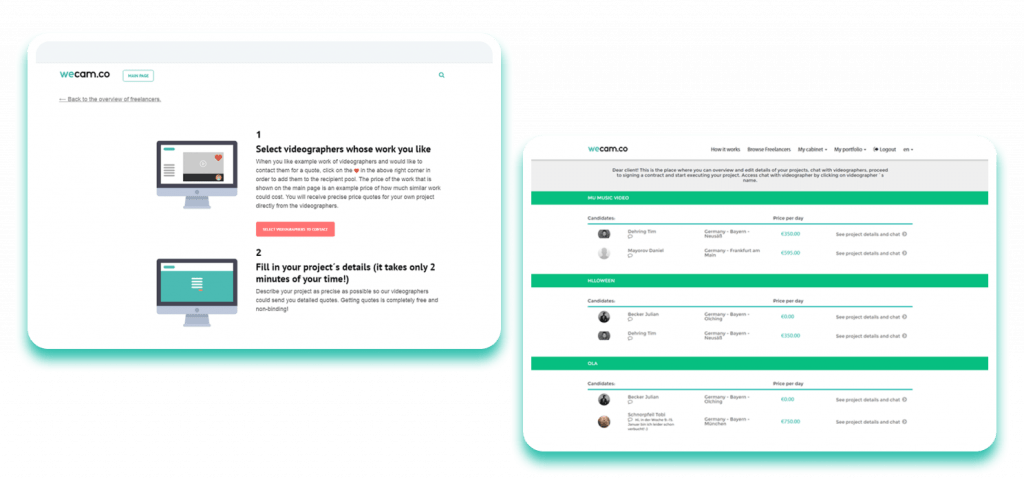
Booking process
- Adding a listing, booking order and receiving details (an order should have a detailed page with time, cost, feedback)
- Accept and decline requests from buyers: if buyers are able to apply for the offer, users should be to choose among these offers (the best option here is automated confirmation, executed with several button clicks)
- Payment details: the payment finalization process should take not more than 1-4 clicks.
Curation
All ecommerce sites, especially peer-to-peer marketplace apps should have clear moderation and banning regiments.
- During ecommerce marketplace development, we write functionality that is responsible for deleting and blocking accounts, ranking them lower in the search results, decreasing ratings, deleting fake reviews, and processing users’ complaints.
- Ethics: users should be able to report verbal abuse or miscommunication issues to the official team;
- Insurance: both sellers and buyers should know the conditions under which they can turn to the support center. The official team specializes in these conditions in Terms of Service and takes responsibility only in determined cases. For instance, a dispute due to a payment failure or downtime, or an interface bug.
Payment criteria
- Location: carrying out payments in one country requires less consideration than international transfers. If we are talking about abroad payments, we usually partner low-commission gateways that minimize cross-border fees.
- Accessibility: which are the mediums for making a payment? Our standard requirements include the support of the web and mobile version. We also care about low-bandwidth performance: a user should be able to carry out a payment even with a low connection.
- Payment data storage: our database experts decide whether the payment data should be stored on the third-party infrastructure or in the local network. We also implement backup, encryption, and hashing mechanisms to prevent leaks.
Customization
A p2p marketplace lending marketplace, chat marketplace, or educational p2p platform can hardly be developed in automated marketplace platforms like ShareTribe or from a template. Profiles and interactions between them are highly specific and personalized. Here’s just a brief list of some must-customize aspects.
- Geolocation: users might like to make purchases with users nearby, with whom they potentially can meet. Or vice versa, they might prefer to talk to someone in another country for cultural exchange or specific local expertise. We set up filters like range, by country, by city, by state, etc.
- Push-notifications: buyers and sellers don’t miss new offers and leads. Push-notifications keeps both parties in the loop and assures more time spent in the app.
- Search filters: the search criteria (rating, location, cost, estimated time, skills, interests, etc) should be easily customizable and apparent on the Search page. This is what we did on HLPRs and KwikiMove, letting people customize their ranking results.
- Personal schedules: both buyers and sellers should be able to manage their personal time, indicate free and busy hours, and signal availability. On HLPRs, our ecommerce marketplace development team did exactly that – buyers specified the time when they expect to get the service, and helpers provided their schedule. The tool found users whose open windows matched.
- Validating the service: at the end of each conversation, users should be invited to rate the service quality. We do this via push-notifications, pop-up windows, and request messages.
Here’s how we did the interface in Fuzu, a job-hiring service marketplace:
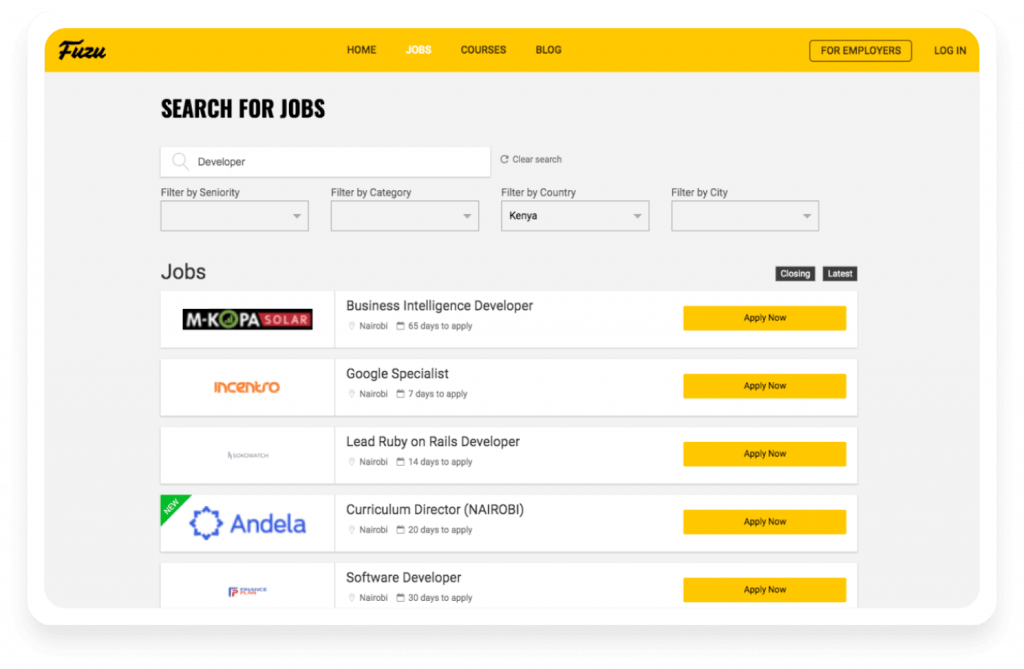
User documentation
- Real-time tracking: users and buyers should be notified when one of them updated schedules, rates, left a review, or changed profile details.
- The tracking number of profile views and visits: these statistics options are usually enabled in the pro version. Both sellers and buyers can see views, statistics, number of people who saw the offer or request.
- Personal statistics: a buyer should be able to see a history tab with all orders, their recipients, and a short description. A seller should track invoices, financial updates. revenue, streams, and daily/weekly/monthly yearly performance. To implement this functionality, the developers’ team integrates an API or builds a custom tracker.
- Reports: a user should be able to generate and export a detailed report on their activity. It can be published on a web page and be accessed via a link or exported as a PDF or XML file.
Again, here’s an example of our peer-to-peer platforms, to give you an idea.
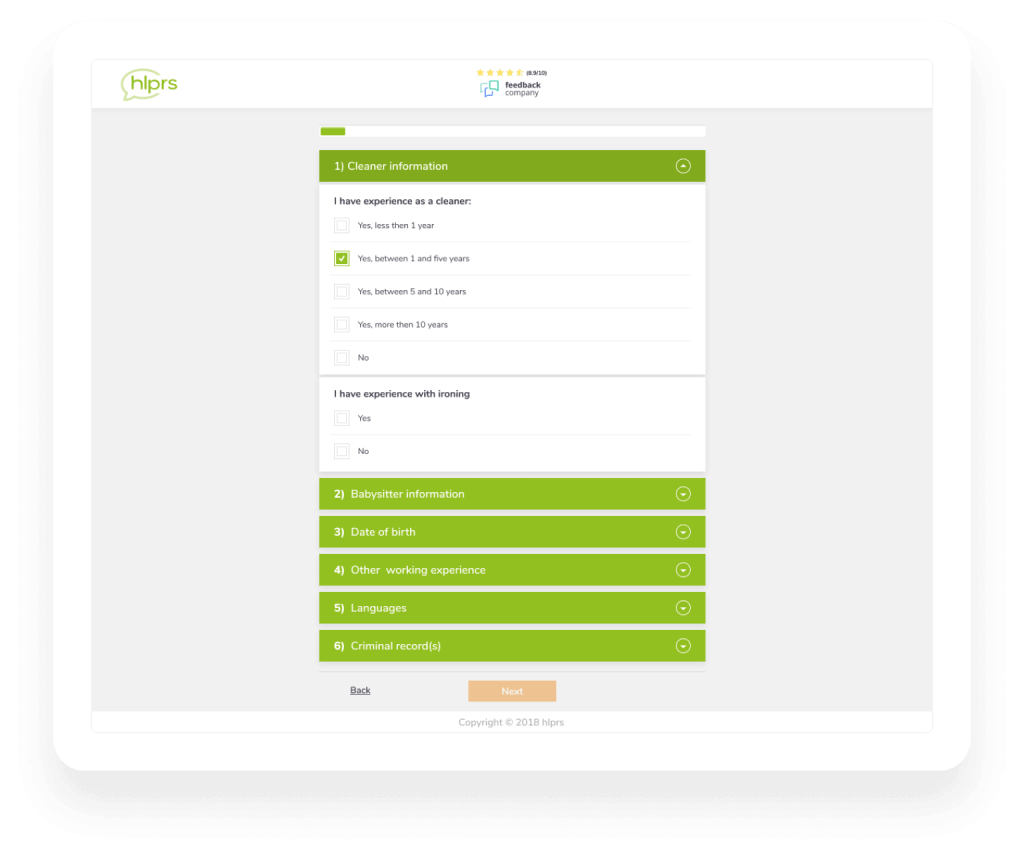
Admin panel
- A separate admin panel interfaces for each user type: depending on the platform, we might also change underlying business logic. The goal is to reuse as much code as possible (for efficiency and lower costs) but still, user experience is the main priority.
- Changing profile data: admin panels allow users to update their personal information, login and registration data, payment methods, check and change privacy settings.
- Communication with the official team: admin panels can feature chat forms and bots that will walk users through the customization process.
- Managing pro and free subscriptions: we implement notifications that encourage users to upgrade the account thought the panel. It’s a simple way to encourage conversion to a pro member.
An example of a simple user profile from HLPRS, a Syndicode-developed peer-to-peer service marketplace: a functional, intuitive, lightweight screen.
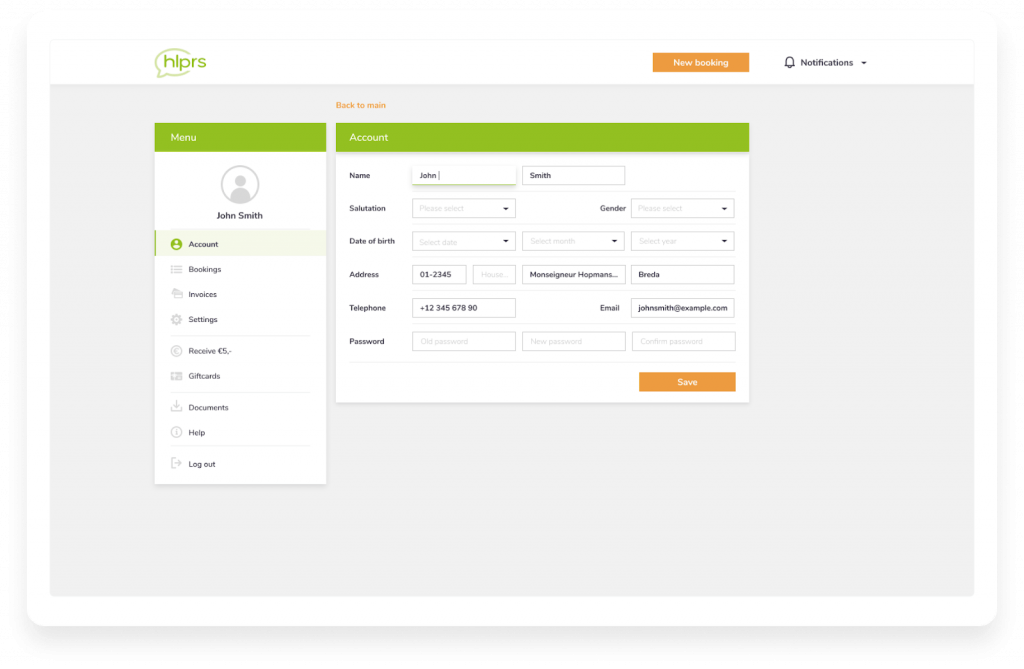
We reviewed the crucial functionality of a peer-to-peer chat marketplace and the best practices for its implementation. Now, let’s sum up the characteristics of a professional P2P chat marketplace.
| Aspect | Our approach |
| Functionality requirements | What’s the type of theproject? How do users register on the platform? User roles and access |
| Monetization | Free trial Paid trial Flat fee or pay-per-use Advertising Partnerships Freemium |
| Making an order | Order system Criteria for making an order Notifying the provider or buyer about invitations or offers: a buyer can contact a user directly or post a public job offer and leave requests. |
| Booking details | Adding a listing, booking an order and receiving details Accepting and decline requests from buyers, viewing and changing payment details |
| Payment criteria | Location – local or international Accessibility: the mediums for making a payment Payment data storage: our database experts decide whether the payment data should be stored on |
| Customization | GeolocationPush-notifications Search filters Personal schedules Validating the service |
| Curation | We write functionality that is responsible for deleting and blocking accounts Ethics: users should be able to report abuse or miscommunication issues to the official team; Insurance: both sellers and buyers should know the conditions under which they can turn to the support center. |
| User documentation | Real-time tracking The tracking number of profile views and visits Managing personal statistics Generating and exporting reports |
Our experience in peer-to-peer website development
Syndicode team specializes in service marketplace development, and in peer-to-peer platforms in particular. We built successful scaled platforms like HLPRS, KwikiMove, Wecam that entered both local and international markets.
As a team that’s focused on ecommerce marketplace development, we are excited to see the direction that the peer-to-peer industry is taken. From lending marketplaces to chat P2P platforms, we are happy to build an innovative platform for you. Get in touch with our developers to build a scalable, secure, and reliable peer-to-peer marketplace platform.
